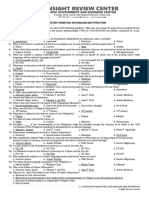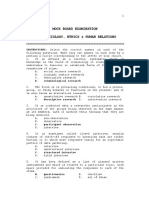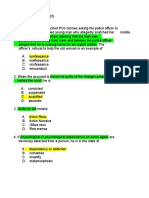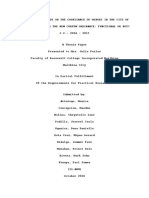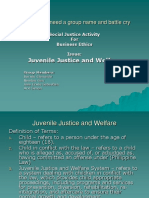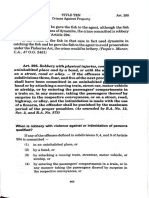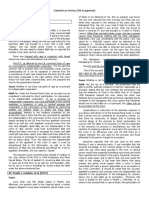Professional Documents
Culture Documents
Review Question On Cdi-1: Fundamentals of Criminal Investigation and Intelligence Prepared By: John Christopher A. Peraz Block - A
Review Question On Cdi-1: Fundamentals of Criminal Investigation and Intelligence Prepared By: John Christopher A. Peraz Block - A
Uploaded by
Christopher Peraz83%(6)83% found this document useful (6 votes)
16K views9 pagesThis document contains a review test on fundamentals of criminal investigation and intelligence with 43 multiple choice questions. It covers topics like the basic legal knowledge required for criminal investigations, activities used to locate criminal offenders like interviews and surveillance, the purpose of conducting interrogations which is to obtain facts and confessions about crimes, and the use of forensic sciences and police intelligence in investigations. It also discusses concepts like the criminal intent or motive that compels a person to commit a crime, elements of the investigative process, and techniques used to identify criminal offenders.
Original Description:
Original Title
Cdi 1- Questioner
Copyright
© © All Rights Reserved
Available Formats
DOCX, PDF, TXT or read online from Scribd
Share this document
Did you find this document useful?
Is this content inappropriate?
Report this DocumentThis document contains a review test on fundamentals of criminal investigation and intelligence with 43 multiple choice questions. It covers topics like the basic legal knowledge required for criminal investigations, activities used to locate criminal offenders like interviews and surveillance, the purpose of conducting interrogations which is to obtain facts and confessions about crimes, and the use of forensic sciences and police intelligence in investigations. It also discusses concepts like the criminal intent or motive that compels a person to commit a crime, elements of the investigative process, and techniques used to identify criminal offenders.
Copyright:
© All Rights Reserved
Available Formats
Download as DOCX, PDF, TXT or read online from Scribd
Download as docx, pdf, or txt
83%(6)83% found this document useful (6 votes)
16K views9 pagesReview Question On Cdi-1: Fundamentals of Criminal Investigation and Intelligence Prepared By: John Christopher A. Peraz Block - A
Review Question On Cdi-1: Fundamentals of Criminal Investigation and Intelligence Prepared By: John Christopher A. Peraz Block - A
Uploaded by
Christopher PerazThis document contains a review test on fundamentals of criminal investigation and intelligence with 43 multiple choice questions. It covers topics like the basic legal knowledge required for criminal investigations, activities used to locate criminal offenders like interviews and surveillance, the purpose of conducting interrogations which is to obtain facts and confessions about crimes, and the use of forensic sciences and police intelligence in investigations. It also discusses concepts like the criminal intent or motive that compels a person to commit a crime, elements of the investigative process, and techniques used to identify criminal offenders.
Copyright:
© All Rights Reserved
Available Formats
Download as DOCX, PDF, TXT or read online from Scribd
Download as docx, pdf, or txt
You are on page 1of 9
REVIEW QUESTION ON CDI-1: FUNDAMENTALS OF CRIMINAL INVESTIGATION AND INTELLIGENCE
PREPARED BY: JOHN CHRISTOPHER A. PERAZ BLOCK -A
1.The basic knowledge on legal matter concerning the criminal investigation:
A. Technical Knowledge B. Knowledge of Criminal Law
C. Perseverance D. Intelligent
2. Activities conducted to trace and locate the criminal offender:
A. Interview B. Tailing
C. Surveillance D. All of the above
3. The cordial questioning of a person who is deemed have knowledge of the commission of crime:
A. Interrogation B. Criminal Investigation
C. Interview D. Investigation
4. The acknowledgement of guilt concerning the commission of crime is called:
A. Admission B. Admission and Confession
C. confession D. Conviction
5. The skillful and aggressive questioning of a person who is believed to have committed a crime:
A. Interview B. Crime Narration
C. Interrogation D. None of the above
6. The use of forensic sciences in the investigation of crime:
A. information B. Instrumentation
C. Interview D. All of the above
7. Purpose of conducting interrogation in a criminal investigation:
A. To find out the facts and truth of the crime
B. To obtain confession and admission
C. Collection of information about the crime
D. All of the above
8. The rightful and wise decision making of a criminal investigation:
A. Endurance B. Good Intelligence
C. Perseverance D. Wisdom of Solomon
9.The person who was a subject for interview:
A. Interviewee B. Victim
C. Suspect D. Witness
10. Judicial confession is made during:
A. Criminal Investigation B. Ongoing Court proceeding
C. Questioning of the Police D. Confession with an attorney
11. The first source of information in order to identify the criminal offender:
A. Investigation Report B. Police Blotter Report
C. Crime Report D. Mass Media Report
12. The use of collected data which is processed by intelligence unit is called:
A. Police Intelligence B. Interpretation of Information
C. Dissemination of Intelligence D. Collation of data
13. Which of the following answer the cardinal question, how?
A. Modus Operandi B. Intent
C. Motive D. Instrumentality
14. It refers to the characteristics of an investigator to uphold the law despite temptation of bride for money:
A. Integrity B. Perseverance
C. Courage D. Endurance
15. The writer sworn statement of a person respecting the knowledge he possess about the commission of crime:
A. Admission of facts B. An affidavit
C. Written confession D. Disposition
16. All except one are the 3 I’s of criminal investigation
A. Information B. Interrogation
C. Interview D. Inquiry
17. The “fruit of the crime” in a case of robbery is:
A. Motive B. Evidence of Crime
C. Stolen Items D. All of the above
18. Criminal investigation is considered as__ because it uses different scientific instrument to investigation and solve the
crime:
A. Art B. Science
C. Process D. Art and Science
19. Which of the following answer the question, when?
A. Corpus Delicte B. Modus Operandi
C. Time and Date D. Place of the Crime
20. To identify the criminal offender, the investigator should refer to:
A. Public Record B. Modus Operandi
C. Private Record D. All of the above
21. Identifying the criminal offender is done thru:
A. Gathering information about him/her B. The use of police intelligence
C. Tracing the criminal offender D. All of the above
22. The three elements of crime are:
A. Intent B. Instrumentality
C. Opportunity D. All of the above
23. An official record of crime incident that is reported to the police
A. Report B. Police Blotter Report
C. Police Crime Incident Report D. All of the above
24. In identifying the criminal offender, the investigator should first refer to the:
A. Testimony of witnesses B. The Complainant
C. The Police Blotter Report D. The Crime Report
25. One of the techniques in Surveillance:
A. Tracing the criminal offender B. Casing the criminal offender
C. Following up the offender D. Stake out on the criminal offender
26. The initial phase of police intelligence cycle
A. Planning the intelligence activity B. Collection of information
C. Evaluation of information D. Dissemination of intelligence
27. To get the complete information about the criminal offender, the investigation must conduct:
A. PBI B. CBI
C. RC D. All of the above
28. The cardinal questions necessary in criminal investigation:
A. The five W’s B. The five W’s and One H
C. Who is the criminal offender D. Who is the victim
29. The use of police sciences in criminal investigation is called:
A. Instrumentation B. Criminalistics
C. Forensic science D. All of the above
30. The in place observation and collection of information about a place and person occupying said place is called:
A. Casing B. Stake-out
C. Surveillance D. Deep penetration
31. The close-in observation of the criminal offender and the activities he is doing is called
A. Stake-out B. Casing
C. Surveillance D. All of the above
32. The collection and analysis of facts and truths about person, things and places in relation to criminality is called:
A. Identification of the criminal B. Intelligence
C. Surveillance D. None of the above
33. The moving power of force which compels a person to commit criminal offense is called:
A. Criminal Act B. Criminal wrong doing
C. Criminal Intent D. Criminal Liability
34. There is no crime when there is _______.
A. No law prohibiting the crime B. No Criminal Law prohibiting the crime
C. No Rules and Regulations prohibiting the crime D. All of the above
35. The use of forensic sciences in the investigation of crime
A. Information B. Interview
C. Instrumentation D. All of the above
36.It deals with the identity, location and arrest of a person who commits a crime and simultaneously identify, collect,
preserve and evaluate evidence for the purpose of bringing criminal offender to justice.
A. Investigation C. Investigative process
B. Criminal investigation D. Criminal inquest
37. Elements of investigative process are_____.
1. Recognition 4. Preservation
2. Collection 5. Evaluation
3. Dissemination
A. 1, 2, 3 and 4 C. 1, 2, 4 and 5
B. 1, 3, 4 and 5 D. 1, 2, 3, 4 and 5
38. Form of relevant and material information that the investigator maybe obtained from regular, cultivated or grapevine
sources are___.
1. Sensory 3. Concrete
2. Written 4. Physical forms
A. 1, 2 and 3 C. 2, 3 and 4
B. 1, 3 and 4 D. 1, 2 and 4
39.Through this tool of criminal investigation tangible things can be used to detect crimes, identify the criminals, facilitate,
and assist the investigator in its task in achieving the objectives of criminal investigation.
A. Information C. Instrumentation
B. Criminalistics D. Interview/Interrogation
40. Which phase of criminal Investigation that the investigator should apprised the person of his right under Republic Act
7438?
A. During the identification of criminal offender
B. During the arrest, detention and interrogation of the offender
C. During the gathering of evidence to prove the guilt of criminal offender
D. During police line-up
41.What specific offence has been committed? Who committed it? When it was committed? Where it was committed? Why
it was committed? And how it was committed? This are called____ of criminal investigation.
A. Cardinal Five W’s and One H C. Golden Rule
B. Three I’s D. Bridges burn
42.One of the stages of criminal investigation Is the identification of criminals, which can be done in any or a combination
of the following, except.
A. By confession or admission by the criminal B. By corpus delicti
C. By circumstantial evidence D. By eyewitness
43.Coerced and uncounselled statements are considered involuntary or forced confession which are usually a/ and_____.
A. Judicial C. Prosecutorial
B. Extra judicial D. Admission
44.After apprising him of his rights under Republic Act 7438, Lauro Galit who was invited and interrogated for the crime of
murder executed an extra-judicial confession acknowledging his guilt to the crime charged. What is the effect of such
confession to his case?
A. It can be used as evidence against him B. He will be convicted for the crime of murder
C. He waived his rights to prove his innocence D. His case will prosper
45.May be in sensory, written or physical forms which can be obtained from regular, cultivated or grapevine sources.
A. Information C. Data
B. Evidence D. Proof
46. An act or declaration made in the presence and within the hearing or observation of a party who does or says nothing,
when the act or declaration naturally calls for action if comment is not true.
A. Admission by Silence C. Admission
B. Res inter alios acta D. Negative pregnant
47. In this process, written confession of the accused is used as a script in describing events of the crime. This strengthens
the prosecutor’s case and serves to convince the judge that the accused was not maltreated nor affected by sinister
psychological influence.
A. Mental reconstruction C. Reconstruction
B. Crime reenactment D. Physical reconstruction
48. Statement no. 1. Confession is a voluntary statement, either oral or written, made by a person charged with the
commission of a crime which he admits participation in, or commission of, the criminal act. It cannot be implied, it should be
direct and positive acknowledgment of guilt. Statement no. 2 Admission is a statement by the accused regarding facts
pertinent to the crime. It tends, in connection with the proof of other facts, to prove the suspect’s guilt. It can be implied.
A. Statement No. 1 is true while statement no. 2 is false
B. Statement No. 1 is false while statement no. 2 is true
C. Statements No. 1 and 2 are both true
D. Statements No. 1 and 2 are both false
49. Which of the following need not be present in order to prove the guilt of the accused by means of confession or
admission?
A. Confession must be supported by corroborative evidence
B. Corpus delicti must be established separately
C. Confession must be voluntarily and freely given
D. Confession must be ratified by the judge or the fiscal
50.Assume that you are an investigator who investigates a murder case perpetrated by an unknown suspect. A person in
the name of Ruel, a call center agent, saw the crime and he is willing to identify the suspect. Which of the following
methods will you not utilize to establish the identity of the suspect?
A. Verbal Description (Portrait Parle) and Rogue’s Gallery (Photographic Files)
B. General Photographs and Cartographic Sketch (Artist’s Assistance) [Composite Artist]
C. Police Line-up
D. Systematic interview that may lead to the identity of a known criminals
51. You are an investigator, investigating a suspected rape-slaying case which was allegedly witnessed by a certain person
who volunteered to identify and testify against the perpetrator. What are the factors that you should not consider to
determine the accuracy of his identification of the suspect?
A. His ability to observe and remember the distinct appearance of the suspect
B. The prevailing conditions of visibility and observation when the crime was committed
C. His state of mind when he witnessed the commission of the crime
D. The lapse of time between the criminal event and when identification was made
52. Circumstantial Evidence is an evidence that indirectly proves a fact in issue through an inference which fact-finder
draws from the evidence presented. It is sufficient to produce the conviction of the accused if___.
1. There are more than one circumstances present
2. The facts from which the inferences derived are proven
3. The combination of all the circumstances is such as to produce a conviction beyond reasonable doubt
A. 1, 2 and 3 C. 2 and 3
B. 1 and 2 D. Only 3
53.You are an investigator who investigates an alleged robbery with homicide case perpetrated by an unknown suspects.
Since there are no witnesses to the crime the following may give you a hint to identify the suspect, except one.
A. Motive and opportunity
B. Declaration and acts indicative of guilt, preparation for a commission of crime and possession of fruits of a crime of
the perpetrator
C. Modus Operandi, associative evidence and criminal potentiality
D. Knowledge, skills, tools or facilities that could easily be adopted to criminal use by the suspect
54.Circumstantial Evidence is an evidence that indirectly proves a fact in issue through an inference which fact-finder draws
from the evidence presented. It is sufficient to produce the conviction of the accused if:
1. There are more than one circumstances present
2. The facts from which the inferences derived are proven
3. The circumstances presented should be supported by testimonial evidence
4. The combination of all the circumstances is such as to produce a conviction beyond reasonable doubt
A. 1 and 3 C. 1, 2 and 3
B. 2 and 4 D. 1, 2 and 4
55. Person who by social or professional position possesses or has access to information of continuing interest, and who
willingly provides information to the police either in response to a specific request or his own initiative.
A. Incidental informant C. Automatic informant
B. Casual informant D. Recruited informant
56. Covert observation of a person, place, or things by human or technical means to acquire information.
A. Surveillance C. Mobile
B. Stationary surveillance D. Technical
57.In this method of shadowing, operatives are station at a fixed point assuming that subject followed the same general
route each day.
A. ABC Method C. Combined Foot- Auto Surveillance
B. Leap Frog Method D. Fixed surveillance
58. Sometimes called “roping”. An investigation technique whereby the operative conceals his true identity and adopts an
assumed role to obtain information or accomplish a specific mission.
A. Undercover assignment C. Work assignment and social assignment
B. Dwelling assignment D. Personal contact assignment
59. You are one of the police operatives tasked to trace a fugitive. Which of the following information for his capture will
you consider?
1. His full name, known aliases, description and distinctive marks, modus operandi, motive and associates
2. His habits, hangouts, criminal record, residence, employment, relatives and close friends 3. His physical condition, LTO
records check, SSS number, selective service history and handwriting specimen
A. 1 and 2 C. 1 and 3
B. 2 and 3 D. 1, 2, and 3
60. You were an investigator who tries to reconstruct the crime scene. What are the components of the crime scene
situation which you would analyzed?
1. Suspect’s arrival at the scene
2. Place of entry
3. Movement of suspect from point of entry and his contact with the victim
4. Place of exit
A. 1, 2, 3 and 4 C. 1, 2 and 4
B.n1, 2 and 3 D. 1, 3 and 4
61. SPO2 Florenz Santos is examining a crime scene, which a dead victim sustained a gunshot wound in the head with a
handgun near his hand. He was informed that the victim had a painful terminal illness. SPO2 Santos concluded that the
wound is self inflicted. This is an example which the investigator use what kind of reasoning?
A. Deductive C. Reasonable
B. Logical D. Inductive
62. Is the covert observation of a person, place, or things by human or technical means to acquire information.
A. Surveillance C. Stationary surveillance
B. Mobile D. Technical
63. Rough tailing or shadowing is the one that___.
A. General impression about the target is needed C. So much precaution is needed
B. The target is aware that he is being tailed D. None of them
64. Statement no. 1. In the reconstruction of a crime, the investigator rational theory of the crime may begins with
deductive logic and later on inductive logic; Statement no. 2. A rational theory of crime is more than a learned guess, but
less than a certainty, but have very high order of probability.
A. Statement no. 1 is true while statement no. 2 is false
B. Statement no. 1 is false while statement no. 2 is true
C. Statements no. 1 and 2 are both true
D. Statements no. 1 and 2 are both false
65.Statement no. 1. In Physical of reconstruction, the physical appearance of the crime scene is reconstructed from the
description, of the witnesses and the indication of the physical evidence. Statement no. 2. In mental reconstruction after
physical reconstruction, conclusions are made about the consistency of the accounts of the various witnesses. No
assumption is made without supporting evidence.
A. Statement no. 1 is correct B. Statement no. 2 is incorrect
C. Statements no. 1 and 2 are both correct D. Statements no. 1 and 2 are both incorrect
66. After reconstructing the crime scene, the following are the minimal requirements to be observed by the investigator to
insure admissibility of photographs in court.. Which of the following is not one of them?
A. The object which is represented should not be immaterial or irrelevant
B. The photograph should not unduly incite prejudice and sympathy
C. The photograph should be free from distortion
D. The photograph should be clearly developed
67.Why does the dead body of the victim of violence needs to be photographed after its removal from the crime scene?
A. To have a set of view showing the relationship of the body with the surrounding
B. To identify the victim and have close-up picture of the wounds
C. To provide reserve picture in case of loss or damage
D. None of them
68.. Photographs to be taken at the scene of the c
A. Over-All and environment’s photograph
B. Photographs of articles of evidence and photographs of the deceased
C. Photographs of the scene of the crime operatives showing their identity
D. Special techniques photograph of the body after
69. It supplements photographs of the crime scene and considered to be the simplest and the most effective way of
showing actual measurements and of identifying significant items of evidence in their location at the scene.
A. Crime scene sketch C. Finished sketch
B. Rough sketch D. Direction sketch
70. In searching for physical evidence at the crime scene, the following types of search could be used depending upon
locale, number of personnel available, type of object sought and speed desired, except:
A. Strip and double strip or grid search C. Rectangular and circular search
B. Zone search D. Spiral and wheel search
71. Which of the following must be done to maintain the physical integrity of evidence?
A. Evidence must be photographed and packaged B. Evidence must be properly documented
C. Maintain its chain of custody D. Identify, tag and seal the evidence
72. Which of the following must be done to maintain the legal integrity of evidence?
A. Evidence must be properly documented B. Maintain its chain of custody
C. Identify, tag and seal the evidence C. Photographed and packaged the evidence
73. The methodology involving the systematic searching, handling, distribution and accountability of all evidence found at
the crime scene, including the documentation of every article of evidence from the point of initial discovery at the scene, to
its collection and transport to the point of examination, its temporary storage and its final disposal is referred to us.
A. Corpus delicti C. Blotter
B. Necropsy report D. Chain of custody
74 To prove the chain of custody of evidence the following must be demonstrated except:
A. The evidence must be free from alteration, contamination and switching
B. The evidence offered is the same evidence found at the scene
C. There is no opportunity to replace or improperly alter the evidence
D. Any change in the condition of the evidence can be explained
75. Which of the following is not one of the questioning techniques that should be utilized in interrogation?
A. Chronological C. Going backward
B. General to specific D. Going upward
76.In questioning a witness, an ideal type of written statement is:
A. Narrative type because it is easier and will be short
B. Question and answer because it provides details of acts
C. Combination of the two
D. Your convenient type
77. Jessie was invited by the NBI operatives to answer questions pertinent to the murder case investigated. After the
questioning at the NBI Headquarters however, he was held for further questioning and considered him a suspect already.
Persons who can visit him are as follows, except:
A. Lovers, friends and countrymen B. Immediate member of his family
C. Any medical doctor, priest or religious minister D. Personnel of the C.H.R.
78. Republic Act No. 7438 defines immediate members of the family are as follows, except:
A. Spouse, fiancé/fiancée, parents, child, brother or sister
B. Grandparents, grandson/daughter, great granddaughter/grandson
C. Uncle, aunt, guardian, ward
D. Relatives, intimate friends and best friends
79. What are the Golden Rules in homicide investigation?
A. Never touch, alter and change the position of anything until identified, measured and photographed
B. If article has been move it can never be restored again to its original position
C. A and B are true
D. None of them
80.The interview of a witness can be described by the acronym IRONIC, which stands for:
A. Inquiry, Recognition, Organization, Novelty, Identity, Continuity
B. Identity, Rapport, Omnipresent, Narration, Inquiry, Conclusion
C. Identity, Recognition, Opening statement, Narration, Inquiry, Conclusion
D. Identity, Rapport, Opening statement, Narration, Inquiry, Conclusion
81. Which one is not a means of recording crime a scene?
A. By photographs C. By sketches
B. By notes D. Surveying
82.Application of all procedures for the search of missing persons.
A. Rogues gallery C. manhunt
B. Tracing D. order of battle
83. Physical evidence are contaminated, altered of shape, damaged or lost because of:
1. Improper packaging
2. Corruption of investigator
3. Non-maintenance of chain of custody
4. Inadequate sampling
A. 1 and 3 C. 1, 2 and 3
B. 2 and 4 D. 1, 2, 3 and 4
84.Statement No. 1-The systematic procedure for verbal description of a person after a short period of visual observation is
termed Portrait Parle; Statement No. 2-Description of police characters which a witness may refer and that is kept by police
unit for purpose of references is Rogue’s Gallery
A. Statement No. 1 is correct while statement No. 2 is incorrect
B. Statement No. 2 is correct while statement 1 is incorrect
C. Statement No.1 and 2 are both correct
D. Statement No.1 and 2 are both incorrect
85. Statement no. 1-Tagging of physical evidence aside from the marking should be made immediately after receipt by the
evidence custodian; Statement no. 2- Marking or labeling of physical evidence should be made at the crime scene upon
collection.
A. Statement No. 1 is correct B. Statement No. 2 is incorrect
C. Statement No.1 and 2 are both correct D. Statement No.1 and 2 are both incorrect
86. Under Republic Act 7438, when does the police’ custody of suspect to a crime commence, hence the latter is entitled to
be informed of his rights under the Miranda doctrine which cannot be waived?
A. At the time of custodial investigation C. During the announcement that he is under arrest
B. During the actual questioning D. At the moment that he is invited for questioning
87. What is the principal psychological factor that contributes to a successful interrogation?
A. Privacy B. Rapport between the interrogator and the subject
C. Legality D. It should be done in the interrogation room with one way mirror
88. Statement no. 1- In spiral method of search, the searchers gather at the center and proceed outward along radius or
spokes. Statement no. 2- In wheel method, the searchers follow each other along the path of a spiral, beginning on the
outside and spiraling in toward the center.
A. Statement No. 1 is correct B. Statement No. 2 is incorrect
C. Statements No.1 and 2 are both correct D. Statements No.1 and 2 are both incorrect
89. “Eavesdropping the crime scene” means___.
A. Extent the estimate of the scene
B. Search physical evidence at the scene
C. Playing the role of a curious spectator and mix with the crowd to listen to their conversation
D. None of the above
CDI 1- Answers:
1.B 64.C 127. 191.
2.D 65.C 128. 192.
3.C 66.D 129. 193.
4.C 67.B 130. 194.
5.C 68.C 131. 195.
6.B 69.A 132. 196.
7.D 70.C 133. 197.
8.D 71.C 134. 198.
9.A 72.C 135. 199.
10.B 73.D 136. 200.
11.B 74.D 137.
12.C 75.B 138.
13.A 76.B 139.
14.A 77.A 140.
15.B 78.D 141.
16.D 79.C 142.
17.C 80.D 143.
18.B 81.D 144.
19.C 82.B 145.
20.D 83.A 146.
21.A 84.C 147.
22.D 85.C 148.
23.B 86.D 149.
24.C 87.A 150.
25.A 88.D 151.
26.A 89.C 152.
27.A 90. 153.
28.B 91. 154.
29.A 92. 155
30.B 93. 156.
31.C 94. 157.
32.B 95. 158.
33.C 96. 159.
34.D 97. 160.
35.C 98. 161.
36.B 99. 162.
37.C 100. 163.
38.D 101. 164.
39.C 102. 165
40.B 103. 166.
41.A 104. 167.
42.B 105. 168.
43.B 106. 169.
44.A 107. 170.
45.A 108. 171.
46.A 109. 172.
47.B 110. 173.
48.C 111. 174.
49.D 112. 175.
50.D 113. 176.
51.C 1 14. 178.
52.A 115. 179.
53.D 116. 180.
54.D 117. 181.
55.B 118. 182.
56.A 119. 183.
57.B 120. 184.
58.A 121. 185.
59.D 122. 186.
60.A 123. 187.
61.A 124. 188.
62.A 125. 189.
63.B 126. 190.
You might also like
- FUNDAMENTALS OF CDI QuestionnaireDocument6 pagesFUNDAMENTALS OF CDI QuestionnaireDioner Ray91% (11)
- POLICE ETHICS Pre and Post TestDocument4 pagesPOLICE ETHICS Pre and Post TestKelvin Insigne75% (4)
- Cdi MockboardDocument11 pagesCdi MockboardSherwin Bryan Malabanan75% (4)
- Dec 2022 QA Character Formation Nationalism and PatriotismDocument4 pagesDec 2022 QA Character Formation Nationalism and PatriotismcriminologyallianceNoch keine Bewertungen
- Crime Detection and Investigation: Prepared by Prof. Jayson Paul VantaDocument41 pagesCrime Detection and Investigation: Prepared by Prof. Jayson Paul VantaTORRES , VENUS100% (1)
- MODULE 4 ArrestDocument10 pagesMODULE 4 ArrestChristopher PerazNoch keine Bewertungen
- Forensic 2 - Mid-Term Exam.Document8 pagesForensic 2 - Mid-Term Exam.Ronalyn Paunal100% (1)
- PRETEST IN LEA 4 - Law Enforcement Operationsand Planning With Crime MappingDocument6 pagesPRETEST IN LEA 4 - Law Enforcement Operationsand Planning With Crime MappingBrian Tiangco50% (2)
- Professional Conduct and Ethical Standard: Criminology 4 Finals CoverageDocument10 pagesProfessional Conduct and Ethical Standard: Criminology 4 Finals Coverageapril mayugba100% (1)
- Mock Board Exam in CDI Set ADocument10 pagesMock Board Exam in CDI Set ALombroso's follower100% (1)
- Crime Detection Review Questions - Criminology Board Exam ReviewerDocument24 pagesCrime Detection Review Questions - Criminology Board Exam ReviewerGibson Jabiniar100% (3)
- Anti Avoidance RulesDocument15 pagesAnti Avoidance RulesAanchal KashyapNoch keine Bewertungen
- Moot Memorial Final RespondentDocument19 pagesMoot Memorial Final RespondentMayank Tripathi100% (1)
- Cdi MCQDocument29 pagesCdi MCQSeagal Umar100% (2)
- Cdi-Q ADocument9 pagesCdi-Q Amelbertgutzby vivasNoch keine Bewertungen
- Cdi Q and A 1Document122 pagesCdi Q and A 1April Delos Reyes TitoNoch keine Bewertungen
- Crime Detection Review QuestionsDocument11 pagesCrime Detection Review QuestionsJovie MasongsongNoch keine Bewertungen
- Cdi 1 - Pre-Rev AssignmentsDocument10 pagesCdi 1 - Pre-Rev AssignmentsBelinda Viernes100% (1)
- Mockboard in Crime Detection With AnswersDocument13 pagesMockboard in Crime Detection With AnswersMark Joseph P. Gania100% (1)
- CDIDocument6 pagesCDILlevon BunaNoch keine Bewertungen
- Pre Test Police Patrol Operation and Crime Mapping Multiple ChoiceDocument6 pagesPre Test Police Patrol Operation and Crime Mapping Multiple ChoiceRanier Factor Aguilar50% (2)
- CDI 4 Final Exam Answer KeyDocument6 pagesCDI 4 Final Exam Answer KeyGarcia Rowell S.Noch keine Bewertungen
- CDI 3 Practice TestDocument103 pagesCDI 3 Practice TestBernel Alegado100% (1)
- Mockboard Crime Detection and InvestigationDocument10 pagesMockboard Crime Detection and InvestigationEmmanuel BuanNoch keine Bewertungen
- CrimsocDocument36 pagesCrimsocAiram Tano100% (1)
- Board Exam Questions For Criminologist: Crime Detection, Investigation, and PreventionDocument121 pagesBoard Exam Questions For Criminologist: Crime Detection, Investigation, and PreventionMa Tiffany Cabigon100% (1)
- SPECIAL CRIME INVEST - QuestionsDocument7 pagesSPECIAL CRIME INVEST - QuestionsDioner Ray100% (3)
- Reviewer in Cri 184 1Document35 pagesReviewer in Cri 184 1Adrian Jumaquio DeosoNoch keine Bewertungen
- Cdi Q&aDocument16 pagesCdi Q&aChristopher Pjunatas100% (1)
- Correctional Administration QuestionsDocument16 pagesCorrectional Administration QuestionsTreb Medz100% (2)
- Cdi Reviewer Compilation'sDocument15 pagesCdi Reviewer Compilation'sMichael Egot100% (3)
- Area 3 CriminalisticsDocument54 pagesArea 3 CriminalisticscriminologyallianceNoch keine Bewertungen
- Mock Board Examination Criminal Sociology, Ethics & Human RelationsDocument14 pagesMock Board Examination Criminal Sociology, Ethics & Human RelationsJayson Castro67% (3)
- Course Audit ExamDocument6 pagesCourse Audit ExamHarrison sajorNoch keine Bewertungen
- 100 CrimsocDocument24 pages100 CrimsocAiram TanoNoch keine Bewertungen
- Ak - Quiz in Police ComparativeDocument30 pagesAk - Quiz in Police ComparativeAngel King Relatives100% (3)
- Intro To Crim 50 Review QuestionsDocument10 pagesIntro To Crim 50 Review QuestionsBimboy CuenoNoch keine Bewertungen
- Forensic 1 Prelim ExamDocument2 pagesForensic 1 Prelim ExamRovi Clarito100% (2)
- CLJ Quiz Part 5Document3 pagesCLJ Quiz Part 5Jayson GeronaNoch keine Bewertungen
- Mock-Board Crim SocioDocument8 pagesMock-Board Crim Sociocriminologyalliance0% (1)
- Crime Detection Review QuestionsDocument12 pagesCrime Detection Review QuestionssumaychengNoch keine Bewertungen
- Quest Review Center: Contact Nos.: 385-4322 / 0926-372-2083 / 0909-873-3892Document6 pagesQuest Review Center: Contact Nos.: 385-4322 / 0926-372-2083 / 0909-873-3892Ma Roxan Dano100% (1)
- Cdi Pre BoardDocument17 pagesCdi Pre BoardAlemar EmilianoNoch keine Bewertungen
- CDI 5 Final Exam Answer KeyDocument12 pagesCDI 5 Final Exam Answer KeyGarcia Rowell S.Noch keine Bewertungen
- Quiz No. 8 Special Crime Investigation With Interview and Interrogation Cdi3Document8 pagesQuiz No. 8 Special Crime Investigation With Interview and Interrogation Cdi3lemueljamito19Noch keine Bewertungen
- LEA.3 pOLICE PATROLdocxDocument4 pagesLEA.3 pOLICE PATROLdocxRico T. MusongNoch keine Bewertungen
- Final Exam KMIADocument10 pagesFinal Exam KMIAAnggayNoch keine Bewertungen
- Traffic MNGTDocument9 pagesTraffic MNGTKhai Loh Work100% (1)
- Review Questions Criminal Investigation, Detection & Prevention INSTRUCTIONS: Select The Correct Answer in Each of The FollowingDocument12 pagesReview Questions Criminal Investigation, Detection & Prevention INSTRUCTIONS: Select The Correct Answer in Each of The FollowingLex Tamen CoercitorNoch keine Bewertungen
- CDI 2 - Final Exam: EnjoyableDocument13 pagesCDI 2 - Final Exam: EnjoyableAllen Alfelor100% (1)
- Criminology Board Exam ReviewerDocument4 pagesCriminology Board Exam ReviewerAceAsabuNoch keine Bewertungen
- Quiz 3-q and A Theories of Crime CausationDocument12 pagesQuiz 3-q and A Theories of Crime CausationCharito Sermon100% (1)
- CDIDocument115 pagesCDIJosephine Magbanua100% (1)
- CRIMINALISTICSDocument6 pagesCRIMINALISTICSJen Paez100% (1)
- Exam For Fundamentals of Inv.Document18 pagesExam For Fundamentals of Inv.Qayes Al-Quqa100% (2)
- Criminology Board Exam ReviewerDocument4 pagesCriminology Board Exam ReviewerAceAsabu50% (2)
- Police PhotographyDocument13 pagesPolice PhotographyJordine Umayam100% (2)
- Pract. Exam Crim 2 Key 1Document3 pagesPract. Exam Crim 2 Key 1Jerome CometaNoch keine Bewertungen
- CDI 1 Review QuestionsDocument3 pagesCDI 1 Review QuestionsMiko Valeros100% (1)
- QTDocument15 pagesQTSeagal UmarNoch keine Bewertungen
- Cdi 1 QuestionsDocument10 pagesCdi 1 QuestionsISNANI TATONoch keine Bewertungen
- Cdi Marathon Ci Sci 1 Sci 2Document701 pagesCdi Marathon Ci Sci 1 Sci 2Rejine May GangeNoch keine Bewertungen
- Cdi AllDocument16 pagesCdi AllChristopher PerazNoch keine Bewertungen
- Prosecution of Civil Action (RULE 111)Document8 pagesProsecution of Civil Action (RULE 111)Christopher PerazNoch keine Bewertungen
- Police Operational PlanningDocument140 pagesPolice Operational PlanningChristopher PerazNoch keine Bewertungen
- Prosecution of Civil Action (RULE 111)Document7 pagesProsecution of Civil Action (RULE 111)Christopher PerazNoch keine Bewertungen
- AADocument10 pagesAAChristopher PerazNoch keine Bewertungen
- A 3Document5 pagesA 3Christopher PerazNoch keine Bewertungen
- B. Facts Are Incomplete: D. Upon Completion of InvestigationDocument5 pagesB. Facts Are Incomplete: D. Upon Completion of InvestigationChristopher PerazNoch keine Bewertungen
- ADocument5 pagesAChristopher PerazNoch keine Bewertungen
- ADocument6 pagesAChristopher PerazNoch keine Bewertungen
- Green Laws: Name: John Christopher A. Peraz Grade: BS-Criminology 4 YearDocument2 pagesGreen Laws: Name: John Christopher A. Peraz Grade: BS-Criminology 4 YearChristopher PerazNoch keine Bewertungen
- 1 Title Page Curfew Ordinance ABM Final 10 Files MergedDocument68 pages1 Title Page Curfew Ordinance ABM Final 10 Files MergedChristopher PerazNoch keine Bewertungen
- Crim 5Document6 pagesCrim 5Christopher PerazNoch keine Bewertungen
- The Effectiveness and Enforcement of A Teen Curfew LawDocument25 pagesThe Effectiveness and Enforcement of A Teen Curfew LawChristopher PerazNoch keine Bewertungen
- Oldak V Credit Bureau of Napa County Inc Chase Receivables FDCPA Complaint PDFDocument16 pagesOldak V Credit Bureau of Napa County Inc Chase Receivables FDCPA Complaint PDFghostgripNoch keine Bewertungen
- Group 1 (We Need A Group Name and Battle Cry: Juvenile Justice and WelfareDocument19 pagesGroup 1 (We Need A Group Name and Battle Cry: Juvenile Justice and WelfareDarwin Dionisio ClementeNoch keine Bewertungen
- Re Delhi Laws ActDocument16 pagesRe Delhi Laws ActAnonymous 5vhpFpWbNoch keine Bewertungen
- Constitution of PakistanDocument13 pagesConstitution of PakistanShirazspsNoch keine Bewertungen
- Criminal Law Art 295-302Document19 pagesCriminal Law Art 295-302Zen ArinesNoch keine Bewertungen
- Office of The Court Administrator Vs LadagaDocument1 pageOffice of The Court Administrator Vs LadagaSheila RosetteNoch keine Bewertungen
- Complaint - Contract - SDocument2 pagesComplaint - Contract - Sapi-448102723Noch keine Bewertungen
- 87: Arban vs. Borja, A.M. No. R-281-RTJ, August 26, 1986Document4 pages87: Arban vs. Borja, A.M. No. R-281-RTJ, August 26, 1986Iris MendiolaNoch keine Bewertungen
- Punjabi and Co LTD V Soc M Rajwani and Co 2009 SCJ 7620160528115236470Document8 pagesPunjabi and Co LTD V Soc M Rajwani and Co 2009 SCJ 7620160528115236470oojageer yeswiniNoch keine Bewertungen
- CrimRev 5th AssignmentDocument9 pagesCrimRev 5th AssignmentLorenzo Luigi GayyaNoch keine Bewertungen
- Malacanang ManilaDocument4 pagesMalacanang ManilaSabrina WalkerNoch keine Bewertungen
- 113622-2002-Alonso v. Cebu Country Club Inc.Document26 pages113622-2002-Alonso v. Cebu Country Club Inc.Darlene GanubNoch keine Bewertungen
- United States v. Wayne Franklin Schneider, 921 F.2d 272, 4th Cir. (1990)Document3 pagesUnited States v. Wayne Franklin Schneider, 921 F.2d 272, 4th Cir. (1990)Scribd Government DocsNoch keine Bewertungen
- Open Letter: DC Inmates With Parole SentencesDocument6 pagesOpen Letter: DC Inmates With Parole SentencesScottNoch keine Bewertungen
- Evidence CasesDocument60 pagesEvidence CasesAiken Alagban LadinesNoch keine Bewertungen
- Writ Jurisdiction and Habeas CorpusDocument40 pagesWrit Jurisdiction and Habeas CorpusRadheyNoch keine Bewertungen
- People v. NunezDocument1 pagePeople v. NunezVener Angelo MargalloNoch keine Bewertungen
- Butler v. The City Police Department Et Al (INMATE 1) - Document No. 3Document4 pagesButler v. The City Police Department Et Al (INMATE 1) - Document No. 3Justia.comNoch keine Bewertungen
- Facts:: MUSTAPHA DIMAKUTA Y MARUHOM v. PEOPLE, GR No. 206513, 2015-10-20Document2 pagesFacts:: MUSTAPHA DIMAKUTA Y MARUHOM v. PEOPLE, GR No. 206513, 2015-10-20Leonard GarciaNoch keine Bewertungen
- Republic vs. Jabson (G.R. No. 200223)Document2 pagesRepublic vs. Jabson (G.R. No. 200223)Ryan Cruz IINoch keine Bewertungen
- Oposa v. Factoran - Case DigestDocument2 pagesOposa v. Factoran - Case DigestRoxanne PeñaNoch keine Bewertungen
- United Arab Emirates: Arab Political Systems: Baseline Information and Reforms - UAEDocument17 pagesUnited Arab Emirates: Arab Political Systems: Baseline Information and Reforms - UAEWanttoemigrate RightnowNoch keine Bewertungen
- SHEIKH ABDUS SABUR Vs RETURNING OFFICER DISTRICT EBDAD880030COM664418Document30 pagesSHEIKH ABDUS SABUR Vs RETURNING OFFICER DISTRICT EBDAD880030COM664418Imran HossenNoch keine Bewertungen
- Section 306Document13 pagesSection 306mohit kumarNoch keine Bewertungen
- Foreign Jurisdiction Clauses in Commercial Contracts - An Indian Perspective - IndiaCorpLawDocument9 pagesForeign Jurisdiction Clauses in Commercial Contracts - An Indian Perspective - IndiaCorpLawHuzaifaNoch keine Bewertungen
- People Vs BorjaDocument5 pagesPeople Vs Borjaeunice demaclidNoch keine Bewertungen
- Prakash V MST SahaniDocument8 pagesPrakash V MST SahaniAditi IndraniNoch keine Bewertungen
- Petitioners: Republic vs. Rosemoor Mining Non-Impairment ClauseDocument2 pagesPetitioners: Republic vs. Rosemoor Mining Non-Impairment ClauseRobelle RizonNoch keine Bewertungen



